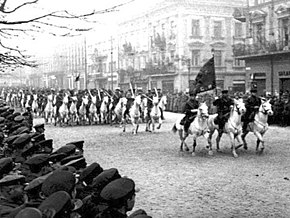Soviet 1939 invasion of Poland
| Soviet invasion of Poland | |||||||||
|---|---|---|---|---|---|---|---|---|---|
| Part of the Invasion of Poland in World War II | |||||||||
 Soviet parade in Lwów, 1939 |
|||||||||
|
|||||||||
| Belligerents | |||||||||
|
|
Supported by: |
||||||||
| Commanders and leaders | |||||||||
|
|||||||||
| Strength | |||||||||
| 20,000 Border Protection Corps, 250,000 Polish Army. |
466,516–800,000 troops 33+ divisions 11+ brigades 4,959 guns 4,736 tanks 3,300 aircraft |
||||||||
| Casualties and losses | |||||||||
| 3,000–7,000 dead or missing, up to 20,000 wounded. 99,149 captured |
1,475–3,000 killed or missing 2,383–10,000 wounded. |
||||||||
The Soviet invasion of Poland was a Soviet military operation that started without a formal declaration of war on 17 September 1939. On that morning, 16 days after Germany invaded Poland from the west, the Soviet Union invaded Poland from the east. The invasion and the battle lasted for the following 20 days and ended on 6 October 1939 with the two-way division and annexation of the entire territory of the Second Polish Republic by both Germany and the Soviet Union. The joint German-Soviet invasion of Poland was secretly agreed to in the Molotov-Ribbentrop Pact, signed on 23 August 1939.
The Red Army, which vastly outnumbered the Polish defenders, achieved its targets by using strategic and tactical deception. Some 230,000 Polish prisoners of war had been captured. The campaign of mass persecution in the newly acquired areas began immediately. In November 1939 the Soviet government ostensibly annexed the entire Polish territory under its control. Some 13.5 million Polish citizens who fell under the military occupation were made into new Soviet subjects following mock elections conducted by the NKVD secret police in the atmosphere of terror, the results of which were used to legitimize the use of force. A Soviet campaign of political murders and other forms of repression, targeting Polish figures of authority, such as military officers, police and priests, began with a wave of arrests and summary executions. Over the next year and a half, the Soviet NKVD sent hundreds of thousands of people from eastern Poland to Siberia and other remote parts of the Soviet Union in four major waves of deportation between 1939 and 1941.
...
Wikipedia
